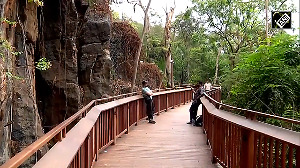It is a rare occasion when this heavily-fortified area between South and North Koreas is thrown open to a leader of any country and External Affairs Minister Pranab Mukherjee became one to have such honour when he undertook a visit to the Korean Demilitarised Zone.
Mukherjee, who was in South Korea for a three-day official visit, came to the Korean Demilitarised Zone for a brief time.
He went into a 1635-mt long tunnel that had been dug by North Korean troops in 1970s to infiltrate into South Korea. South Korean soldiers also briefed him about the place and its history.
The Demilitarised Zone is a 4 km-wide strip of land straddling the 151-mile-long Military Demarcation Line.
It was created when the two sides agreed under the 1953 Armistice Ceasefire Agreement not to enter the territory, air space or contiguous waters under control of the other.
However, North Korea has been violating the agreement, South Korean military officials in the Korean Demilitarised Zone said. It has dug at least four tunnels to infiltrate its soldiers into South Korea through this area.
One of them, the 3rd tunnel which Mukherjee visited, was discovered on October 17, 1978, after information given by defector Kim Bu-sung.
The 1635-mt-long tunnel is two meters tall and two meters wide, about the same size as the 2nd tunnel.
According to South Korean military officials, about 30,000 soldiers with heavy arms could pass per hour through the tunnel dug at the depth of 73 mt.
"The purpose was to capture Seoul, which is just about 44 km away from the Korean Demilitarised Zone, within six hours," a military official said.
North Koreans took about three years to make the tunnel, using small dynamites.
"If the tunnel had not been discovered and digging was continued, the North Korean soldiers could emerge from underneath in Seoul," he said.
After detecting the tunnel, North Koreans painted its walls in yellow at some places before abandoning it. "This was to show that they had dug the tunnel for mining," the South Korean official said adding, "but the area only has granites, meaning there are no (mineral) reserves."
According to Kim Bu-sung, North Korea planned to make five southern exits. Normally one or two were to be used, but in a decisive stage all were to be put into use. It was designed for both conventional warfare and guerrilla infiltration.
From a watch tower, one could see some border areas of North Korea, like the Industrial city and Propaganda town.
The DMZ houses some two million soldiers and qualifies for the world's most heavily fortified border.






 © 2025
© 2025